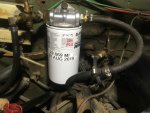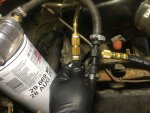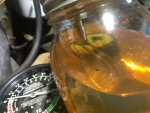Zen Diesel
New member
- 21
- 1
- 3
- Location
- College Park, Maryland
Howdy folks, so brief re-intro I purchased a 1985 CUCV a couple months ago off eBay and I have been inspecting it and taking notes and (re)reading the gee golly willakers out of Steel Soldiers and my reference material and I am stumped.
So a little background the PO (Previous Owner) told me that he was selling the truck because it had an air leak in the fuel system and that it had gotten so hard to start that he had given up on on it. I knew this prior to purchasing and had planned to replace the fuel lines anyways. What he didn't disclose is that he tried to troubleshoot it. I'm not going to get too gnarly with the details because I am making a video of my troubleshooting journey.
What I will say is this any part of the fuel system that was easily accessibly has been hacked horribly. By this I mean that 1/4 line is coupled to 3/8 line (poorly) that then goes through the fuel filter and turns back into 1/4 line but then there is also a separate fuel line stuck in an old bottle of gatorade hanging off the fuel filter with a brass petcock. I'm not sure if he was trying to bypass the lift pump or bleed the system of air. I do know I have about $30 worth of plumbing fittings on the fuel system and its all non-sensical the way its hooked up. I can rotate a couple of the fittings by hand in the fuel line so I know for a fact air is getting into the fuel lines that way.
The PO kind of sort of followed advice similar to what I have seen online for troubleshooting and kind of freelanced in ways that make my head hurt. I tried reaching out to him to try to understand what he was trying to do but I haven't heard back. Doesn't really matter its all coming out anyways.
I put a vacuum jar on the end of the fuel system just prior the fuel filter and pulled a mild vacuum with my mity vac and I was impressed with the amount of air the I was able to draw along with the fuel. He had split the line and put a hose coupler inline. I assumed it was to put a combo fuel gauge (vacuum and low pressure fuel gauge) inline but once I separated it I found it was a 1/4 line coupled to a 3/8 fuel line with screw clamps. That one got a verbal "WTAF" from me. After the fuel filter on the way to the IP there is a section of clear PVC and another chunk of brass adapters before changing back into fuel line. By my count I am just under a dozen places where air could be getting into the system and I haven't even gotten to the mechanical fuel pump yet.

I also sucked a chunk of rubber through the line as well while I was using the jar. This is the second chunk of rubber, that last I found while examining the fuel in the old fuel filter (that has since been changed). Part of the reason I am working my way through changing all the lines out.
So my question is where in the fuel supply chain is the 1/4 line used and where is the 3/8 line used. I assumed I would be able to pull the old lines off and use them as a template but the more I dig the more I am realizing that the entire fuel system has been hacked up and I just can't trust the way the truck came to me. It seems to me the 3/8 should be the supply side and the 1/4 should be the return line but before I go chopping up $50 worth of fuel lines and doing it wrong I wanted to confirm with someone. My hard lines are in tact on the truck but I haven't had a chance to test them yet.
Also I am planning on decommissioning the petcock that is hanging off my fuel filter. I don't have the plug for that port on the filter housing and I had already planned to put a fuel pressure sending unit on my fuel system already so I am looking for recommendations for a brand if someone has already done this kind of modification. I am planning to keep an eye on my lift pumps performance. I am planning to keep the truck mechanical (personal preference) and AFAIK it has the original pump on the engine.
Sorry this is so long.
So a little background the PO (Previous Owner) told me that he was selling the truck because it had an air leak in the fuel system and that it had gotten so hard to start that he had given up on on it. I knew this prior to purchasing and had planned to replace the fuel lines anyways. What he didn't disclose is that he tried to troubleshoot it. I'm not going to get too gnarly with the details because I am making a video of my troubleshooting journey.
What I will say is this any part of the fuel system that was easily accessibly has been hacked horribly. By this I mean that 1/4 line is coupled to 3/8 line (poorly) that then goes through the fuel filter and turns back into 1/4 line but then there is also a separate fuel line stuck in an old bottle of gatorade hanging off the fuel filter with a brass petcock. I'm not sure if he was trying to bypass the lift pump or bleed the system of air. I do know I have about $30 worth of plumbing fittings on the fuel system and its all non-sensical the way its hooked up. I can rotate a couple of the fittings by hand in the fuel line so I know for a fact air is getting into the fuel lines that way.
The PO kind of sort of followed advice similar to what I have seen online for troubleshooting and kind of freelanced in ways that make my head hurt. I tried reaching out to him to try to understand what he was trying to do but I haven't heard back. Doesn't really matter its all coming out anyways.
I put a vacuum jar on the end of the fuel system just prior the fuel filter and pulled a mild vacuum with my mity vac and I was impressed with the amount of air the I was able to draw along with the fuel. He had split the line and put a hose coupler inline. I assumed it was to put a combo fuel gauge (vacuum and low pressure fuel gauge) inline but once I separated it I found it was a 1/4 line coupled to a 3/8 fuel line with screw clamps. That one got a verbal "WTAF" from me. After the fuel filter on the way to the IP there is a section of clear PVC and another chunk of brass adapters before changing back into fuel line. By my count I am just under a dozen places where air could be getting into the system and I haven't even gotten to the mechanical fuel pump yet.

I also sucked a chunk of rubber through the line as well while I was using the jar. This is the second chunk of rubber, that last I found while examining the fuel in the old fuel filter (that has since been changed). Part of the reason I am working my way through changing all the lines out.
So my question is where in the fuel supply chain is the 1/4 line used and where is the 3/8 line used. I assumed I would be able to pull the old lines off and use them as a template but the more I dig the more I am realizing that the entire fuel system has been hacked up and I just can't trust the way the truck came to me. It seems to me the 3/8 should be the supply side and the 1/4 should be the return line but before I go chopping up $50 worth of fuel lines and doing it wrong I wanted to confirm with someone. My hard lines are in tact on the truck but I haven't had a chance to test them yet.
Also I am planning on decommissioning the petcock that is hanging off my fuel filter. I don't have the plug for that port on the filter housing and I had already planned to put a fuel pressure sending unit on my fuel system already so I am looking for recommendations for a brand if someone has already done this kind of modification. I am planning to keep an eye on my lift pumps performance. I am planning to keep the truck mechanical (personal preference) and AFAIK it has the original pump on the engine.
Sorry this is so long.
Last edited:





